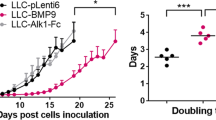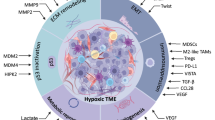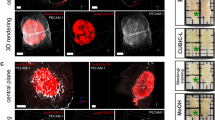Abstract
Normalization of tumor vasculature is an emerging strategy to improve cytotoxic therapies. Here we show that eliminating nitric oxide (NO) production from tumor cells via neuronal NO synthase silencing or inhibition establishes perivascular gradients of NO in human glioma xenografts in mice and normalizes the tumor vasculature, resulting in improved tumor oxygenation and response to radiation treatment. Creation of perivascular NO gradients may be an effective strategy for normalizing abnormal vasculature.
This is a preview of subscription content, access via your institution
Access options
Subscribe to this journal
Receive 12 print issues and online access
$209.00 per year
only $17.42 per issue
Buy this article
- Purchase on Springer Link
- Instant access to full article PDF
Prices may be subject to local taxes which are calculated during checkout


Similar content being viewed by others
References
Fukumura, D. & Jain, R.K. Microvasc. Res. 74, 72–84 (2007).
Jain, R.K. Science 307, 58–62 (2005).
Fukumura, D., Kashiwagi, S. & Jain, R.K. Nat. Rev. Cancer 6, 521–534 (2006).
Kashiwagi, S. et al. J. Clin. Invest. 115, 1816–1827 (2005).
Yu, J. et al. Proc. Natl. Acad. Sci. USA 102, 10999–11004 (2005).
Gerhardt, H. & Betsholtz, C. Cell Tissue Res. 314, 15–23 (2003).
Abramsson, A., Lindblom, P. & Betsholtz, C. J. Clin. Invest. 112, 1142–1151 (2003).
van der Zee, R. et al. Circulation 95, 1030–1037 (1997).
Babaei, S. et al. Am. J. Pathol. 162, 1927–1936 (2003).
Igarashi, J., Bernier, S.G. & Michel, T. J. Biol. Chem. 276, 12420–12426 (2001).
Dulak, J. et al. Arterioscler. Thromb. Vasc. Biol. 20, 659–666 (2000).
Ziche, M. et al. Circ. Res. 80, 845–852 (1997).
Hall, E.J. & Giaccia, A.J. Radiobiology for the Radiobiologist 85–105 (Lippincott, Williams & Wilkins, Philadelphia, 2006).
Mitchell, J.B. Cancer Res. 53, 5845–5848 (1993).
Pou, S., Pou, W.S., Bredt, D.S., Snyder, S.H. & Rosen, G.M. J. Biol. Chem. 267, 24173–24176 (1992).
Acknowledgements
We thank H.D. Suit and K.D. Held for their insightful suggestions; L.L. Munn, D. Fuja and C.D. Ley for their assistance in image analysis; D. Laccore for her assistance in hypoxia detection; S.S. Chae for his assistance in western blot analysis; P. Huang for his direction of the gnotobiotic animal facility; and M. Fortier, J. Kahn, M. Riley, S. Roberge, E. Smith and C. Smith for their excellent technical assistance. This work was supported by National Cancer Institute grants R01-CA96915 (D.F.) and P01-CA80124 (R.K.J. and D.F.).
Author information
Authors and Affiliations
Contributions
S.K. performed most of the experiments; K.T. and J.M. performed intravital microscopy and animal studies; L.X. contributed to mutant cell generation and molecular analysis; S.V.K. and L.E.G. contributed to radiation studies and writing; J.A.T. contributed to image analysis; W.C.S. contributed to the cavtratin study; S.K., R.K.J. and D.F. designed the study, analyzed the data and wrote the manuscript.
Corresponding author
Supplementary information
Supplementary Text and Figures
Supplementary Figs. 1–6 and Supplementary Methods (PDF 6364 kb)
Rights and permissions
About this article
Cite this article
Kashiwagi, S., Tsukada, K., Xu, L. et al. Perivascular nitric oxide gradients normalize tumor vasculature. Nat Med 14, 255–257 (2008). https://doi.org/10.1038/nm1730
Received:
Accepted:
Published:
Issue Date:
DOI: https://doi.org/10.1038/nm1730
This article is cited by
-
Thermal immuno-nanomedicine in cancer
Nature Reviews Clinical Oncology (2023)
-
Delivery of nitric oxide with a nanocarrier promotes tumour vessel normalization and potentiates anti-cancer therapies
Nature Nanotechnology (2019)
-
SOD3 improves the tumor response to chemotherapy by stabilizing endothelial HIF-2α
Nature Communications (2018)
-
Exercise-dependent regulation of the tumour microenvironment
Nature Reviews Cancer (2017)
-
A cerebellar window for intravital imaging of normal and disease states in mice
Nature Protocols (2017)



